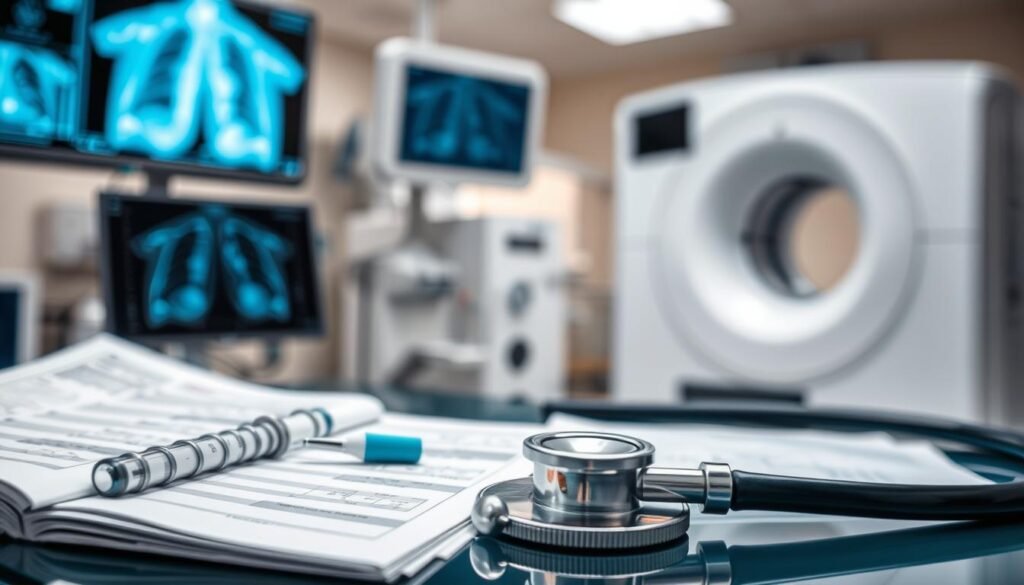About 30% of people with small cell lung cancer (SCLC) are found to have extensive-stage disease. This type of lung cancer grows quickly and spreads early. Knowing more about it is key for those dealing with its effects.
This guide talks about SCLC, especially treatments for its advanced stage. We highlight the importance of finding it early and using effective lung cancer treatments. You’ll learn helpful ways to face this tough challenge.
The outcome for small cell lung cancer can depend a lot on the diagnosis and chosen treatments. This piece aims to provide information to help patients and their families better manage life with SCLC.
Key Takeaways
- Small cell lung cancer comprises 10-15% of lung cancer cases.
- Smoking is the primary risk factor associated with SCLC.
- Rapid detection through imaging is vital for effective treatment.
- Chemotherapy and immunotherapy are the main treatments for extensive-stage SCLC.
- Understanding symptoms can lead to timely medical intervention.
- Clinical trials represent a promising avenue for novel treatments.
- Prognosis often depends on the stage and health status of the patient.
Understanding Small Cell Lung Cancer
Small cell lung cancer (SCLC) grows quickly in the lung tissues. It’s very aggressive, so finding and treating it early is key. Sadly, many find out they have it when it’s already advanced. This affects their chances of getting better. Knowing about the types of small cell lung cancer helps in treating this illness.
What is Small Cell Lung Cancer?
This type of cancer comes in two forms: small cell carcinoma and combined small cell carcinoma. Most people with SCLC have small cell carcinoma. It grows fast and spreads early. Combined small cell carcinoma is less common. It shows traits of both small cell and non-small cell lung cancers. This makes choosing treatments harder.
When diagnosed, about 1 in 3 patients have their cancer in one lung, sometimes including nearby lymph nodes. But, 2 in 3 have cancer that has spread much more. This shows just how serious the situation is right off the bat.
Types of Small Cell Lung Cancer
The main stages of small cell lung cancer (SCLC) are:
| Stage Type | Description | Treatment Options |
|---|---|---|
| Limited Stage | Cancer is only in one lung and maybe nearby lymph nodes. | Could be cured with chemotherapy and radiation therapy. |
| Extensive Stage | Cancer has spread to the other lung or far-off parts. | Focuses on easing symptoms, not cure. |
The TNM system is very important for lung cancer. It looks at tumor size, if lymph nodes are involved, and if it has spread. Knowing the lung cancer characteristics and stages helps patients decide on treatments. And it sets realistic hopes.
Screenings like low-dose CT scans can really help find it early. This improves chances of getting better. For more about detecting it early and treatment options, here’s a good resource.
Risk Factors Associated with Small Cell Lung Cancer
Knowing the risk factors for small cell lung cancer (SCLC) is key. It helps in preventing and catching the disease early. There are several major risks that boost the chance of getting SCLC. It’s important to know these, especially because the disease can be severe.
Major Risk Factors
Smoking is the top risk factor for small cell lung cancer. It’s linked to over 95% of all cases. This risk isn’t just for active smokers but also includes secondhand smoke exposure. Using tobacco in any way greatly increases the SCLC risk. It depends on how much and how long you smoke.
- Heavy smoking: Those who smoke a lot for many years face the highest risk.
- Occupational hazards: Being around harmful substances like asbestos and arsenic also ups the risk significantly.
- Radiation exposure: If you’ve had radiation therapy to the chest before, it could lead to lung cancer.
- Age: Older people are more likely to get SCLC.
For more details on major risk factors, check out the American Cancer Society.
Other Contributing Factors
Other factors also contribute to small cell lung cancer risk. These factors add to the overall risk profile. Let’s explore them.
- Genetic predispositions: Having lung cancer in your family history can raise your own risk.
- Socioeconomic status: People from lower socioeconomic backgrounds see higher lung cancer rates.
- Environmental exposure: Exposure to radon gas is another risk factor for lung cancer.
Looking at all these factors gives us a fuller picture of lung cancer risks. Smokers should consider quitting. Stopping smoking at any age can greatly lower the risk for SCLC and other issues. For more on small cell lung cancer codes and treatment, visit Care Your Lungs.
Symptoms of Small Cell Lung Cancer
Knowing the symptoms of small cell lung cancer is key for early treatment. Spotting these signs early can lead to quick help, which helps patients a lot.
Common Symptoms
Some symptoms are common in people with small cell lung cancer. These include:
- Chronic cough
- Shortness of breath and wheezing
- Chest pain or discomfort
- Presence of blood in sputum
- Unexplained weight loss and fatigue
These signs usually develop slowly, over a few months. Often, patients wait a bit before they seek medical attention for lung cancer.
When to Seek Medical Attention
If you have trouble breathing or feel chest pain, get help right away. These symptoms could mean the cancer is getting worse. Catching these signs early is key to starting treatment soon.
People who smoked a lot or were around harmful things need to watch for these signs. Knowing about early detection is very important. It means you should go for regular check-ups. If you want to learn more about treatments, check out this radiation therapy guide.
| Symptoms | Duration Before Seeking Attention |
|---|---|
| Chronic cough | 2-3 months |
| Shortness of breath | 2-3 months |
| Chest pain | Immediate noticeable discomfort |
| Blood in sputum | Immediate concern |
| Unexplained weight loss | Gradual over months |
Diagnosing Small Cell Lung Cancer Extensive
Diagnosing small cell lung cancer involves comprehensive tests. These tests accurately identify the disease’s presence and stage. Patients often visit specialized centers like Dana-Farber Brigham Cancer Center. Here, advanced procedures help make a precise diagnosis.
Diagnostic Tests and Procedures
Effective diagnosis requires multiple imaging and laboratory assessments. The methods commonly used include:
- Chest X-ray: This first imaging test can show lung structure abnormalities.
- CT Scan: It provides detailed images for assessing tumor size and position.
- Biopsy Procedures: Techniques like fine-needle aspiration or bronchoscopy collect tissue samples for analysis.
- Endobronchial Ultrasound: Helps sample tumors near the airways.
- Radial Endobronchial Ultrasound: Reaches deeper lung tissue sampling suspicious growths.
- Electromagnetic Navigation Bronchoscopy: Locates lung tumors and aids in targeted radiation therapy.
Most procedures are under sedation or general anesthesia, allowing patients to go home the same day. For more details, visit this resource.
Staging Assessment
Staging small cell lung cancer is key for treatment options. This cancer is divided into two main categories:
- Limited Disease: Cancer is on one chest side, making radiotherapy effective. Patients often get chemotherapy with radiotherapy.
- Extensive Disease: Cancer has spread far, sometimes to distant organs. Here, chemotherapy and often immunotherapy are primary treatments.
Staging is vital for treatment choices, based on cancer traits, location, and patient’s health. The TNM system is used for staging, considering Tumor size, Node involvement, and Metastasis. Health professionals tailor treatment plans with comprehensive evaluations.

Small Cell Lung Cancer Extensive: Treatment Options
Treatment options for lung cancer help improve patient outcomes in extensive-stage small cell lung cancer (SCLC). These therapies depend on the cancer’s stage and the patient’s health. A mix of chemotherapy and immunotherapy tackles the challenges of this tough cancer.
Primary Treatment Modalities
The main treatment for extensive stage lung cancer often includes chemotherapy. Drugs like etoposide and platinum-based medicines such as cisplatin or carboplatin are common. They aim to decrease tumor size and manage symptoms. Unfortunately, the average survival rate for extensive-stage SCLC is between 6 to 12 months. This shows how fierce the disease is. For more info on treatment strategies, check out this guide.
Combination Therapies
Today, lung cancer treatments are focusing more on combination therapies. Mixing chemotherapy with immunotherapy agents like atezolizumab or durvalumab is key. This strategy boosts the treatment’s effectiveness. Even though surgery is rare for extensive-stage cases, palliative care is essential. It helps manage symptoms and improves life quality. Thanks to ongoing research and clinical trials, new treatment mixes are being tested. These advanced treatment options for lung cancer could greatly help patients.
| Treatment Modality | Purpose | Example Agents |
|---|---|---|
| Chemotherapy | Reduce tumor burden | Etoposide, Cisplatin, Carboplatin |
| Immunotherapy | Boost immune system response | Atezolizumab, Durvalumab |
| Palliative Care | Manage symptoms and enhance quality of life | Radiotherapy, Brachytherapy, Stent insertion |
Chemotherapy for Small Cell Lung Cancer
Chemotherapy plays a key role in treating small cell lung cancer, especially in its advanced stages. It helps control the disease and improve survival chances. Knowing what drugs are used and their importance can help patients and caregivers.
Common Chemotherapy Drugs
Some chemotherapy treatments mix drugs proven to fight small cell lung cancer. Commonly used chemotherapy drugs for this cancer include:
- Etoposide
- Cisplatin
- Carboplatin
These drugs aim to stop cancer cells from dividing and to shrink tumors. If the cancer comes back or gets worse, other drugs may be used. These include:
- Topotecan
- Docetaxel
- Paclitaxel
- Gemcitabine
The Role of Chemotherapy in Treatment
Chemotherapy is crucial for treating extensive-stage small cell lung cancer. It’s given through the veins in three to four-week cycles. A typical plan includes four to six cycles, adjusting as needed. This method aims to manage the disease while keeping life quality and side effects in mind.
Chemotherapy can cause side effects like:
- Nausea
- Vomiting
- Fatigue
- Hair loss
- Mouth sores
Even with side effects, chemotherapy often improves survival for people with SCLC. When used with immunotherapy for extensive-stage cancer, it can be even more effective. This shows how vital chemotherapy is in treating this aggressive lung cancer.
Radiation Therapy for Lung Cancer
Radiation therapy is key in treating lung cancer, especially for those with small cell lung cancer. It can aim to cure or relieve symptoms. For patients with extensive-stage small cell lung cancer, adding radiation to their treatment plan can be very helpful. It’s crucial for easing symptoms caused by the tumor growing.
Overview of Radiation Therapy
Radiation therapy varies depending on the cancer stage. For limited-stage small cell lung cancer, it’s often used with chemotherapy. This is called concurrent chemoradiation. Those with more advanced cancer may get radiation after chemotherapy. Techniques like external beam radiation therapy (EBRT) target the cancer while sparing healthy tissue. Advanced methods like intensity-modulated radiation therapy (IMRT) and stereotactic body radiation therapy (SBRT) are more precise. They tend to have fewer side effects.
Radiation in Symptom Management
Radiation is vital for managing symptoms in lung cancer patients. It helps ease pain, bleeding, and trouble breathing. These treatments can greatly improve life quality. Prophylactic cranial irradiation (PCI) is an option for some to reduce the risk of brain metastases. This treatment has significantly lowered the incidence of brain spread, improving survival rates.
For those undergoing lung cancer radiation treatment, the schedule usually involves treatment once or twice a day. This occurs five days a week, for 3 to 7 weeks. This schedule balances effective dosing with monitoring for side effects such as fatigue and nausea. Overall, radiation therapy can greatly help in managing extensive-stage small cell lung cancer symptoms and improving patient outcomes.
Immunotherapy in Treating Extensive-Stage Small Cell Lung Cancer
Immunotherapy marks a major breakthrough in treating extensive-stage lung cancer. It boosts the body’s immune system to battle cancer cells. Medications like atezolizumab and durvalumab work well with traditional chemo. Together, they can make treatment more effective.
What is Immunotherapy?
Small cell lung cancer immunotherapy works by activating the body’s immune system against cancer. It uses monoclonal antibodies to stop cancer from hiding from the immune system. This approach offers a more personalized and effective way to fight extensive-stage lung cancer through immunotherapy.
Benefits of Immunotherapy
The benefits of immunotherapy for patients with extensive-stage small cell lung cancer are significant. Key advantages include:
- Potential for improved survival rates: Studies show that immunotherapy can boost overall survival rates beyond standard treatments.
- Reduction in tumor burden: This method can greatly shrink tumors. This helps patients enjoy a better quality of life.
- Longer progression-free survival: Patients often live longer without their disease worsening when receiving immunotherapy along with chemotherapy.
- Targeted approach: Certain immunotherapies work better on specific cancer subtypes. This leads to customized treatment plans.

The ongoing research in immunotherapy for small cell lung cancer looks promising. It may revolutionize treatment strategies. This offers new hope for patients battling extensive-stage disease.
Prognosis and Survival Rates for Small Cell Lung Cancer
Understanding the outlook for small cell lung cancer is key. Most new cases are diagnosed at an advanced stage. This means the cancer has already spread significantly. The chance of beating the disease depends on how advanced it is, the patient’s health, and how well they respond to treatment.
Understanding Prognosis
The outlook for this type of lung cancer can be tough. Without treatment, people usually live 2 to 4 months after being diagnosed. With treatment, this can increase to 7 to 11 months. Chemotherapy is the main way to treat it, but surgery and radiation are not effective for late-stage disease.
Statistics on Survival Rates
How long people live with lung cancer depends a lot on the stage when it’s found. Here are some numbers for different stages:
| Stage | 5-Year Relative Survival Rate |
|---|---|
| Localized Small Cell Lung Cancer | 30% |
| Regional Small Cell Lung Cancer | 18% |
| Distant Small Cell Lung Cancer | 3% |
| All Stages Combined for Small Cell Lung Cancer | 7% |
These stats highlight the urgent need for better treatments. Finding new ways to fight this disease is crucial for improving the outlook for patients.
Clinical Trials and New Treatments
Clinical trials are key for improving treatments for advanced small cell lung cancer. Patients can try new therapies and help advance cancer care. This participation not only helps them but also shapes future treatment options.
Why Participate in Clinical Trials?
Joining clinical trials gives patients access to new treatments not yet broadly available. These studies aim to improve survival and lessen side effects compared to standard treatments. Benefits include access to new therapies, better care from close monitoring, and helping advance medical science.
- Access to innovative and potentially effective new treatment options for small cell lung cancer.
- Close monitoring by healthcare professionals, leading to better care and support.
- The opportunity to contribute to the advancement of medical knowledge and help others facing similar challenges.
Emerging Treatment Options
Recent trials have found new promising treatments for small cell lung cancer. For instance, tarlatamab has led to significant tumor reduction in 40% of patients at a 10 mg dose. They also had a median survival of 14.3 months.
Other significant treatments include:
- Nivolumab (Opdivo): Approved after failure with platinum chemotherapy.
- Lurbinectedin (Zepzelca): Fast-tracked for approval by the FDA for spread cases.
- Tecentriq (atezolizumab) combined with chemotherapy is now a first-line treatment for advanced cases.
- Trials combining talazoparib with temozolomide show promise for personalized treatment strategies.
The search for biomarkers is improving how we match treatments to patient needs. This progress marks a hopeful time for people with small cell lung cancer. It stresses the need to talk about clinical trials with healthcare professionals.

Conclusion
Handling advanced small cell lung cancer needs teamwork across different treatments like drugs, radiation, and new therapies. It’s key to know the disease well, including its risks and how to treat it. This is vital for both those with lung cancer and their supporters. Most people find out they have advanced cancer at the start, which shows the need for custom treatments to get better results.
New treatments for advanced lung cancer are showing promise. Studies show that adding new therapies to standard ones can work better and help people live longer. Yet, even with the best first treatments, many patients see a limited improvement. Survival rates are low, with average survival between 8 to 13 months. This fact highlights why clinical trials are important for accessing new, possibly better treatments.
The situation with lung cancer treatments is always changing. Getting the latest medical advice and learning about new treatments is crucial. Since everyone’s experience with cancer is different, talking often with doctors is key to deal with advanced lung cancer. Looking ahead, being active in treatment decisions can hugely influence how this tough cancer is managed.